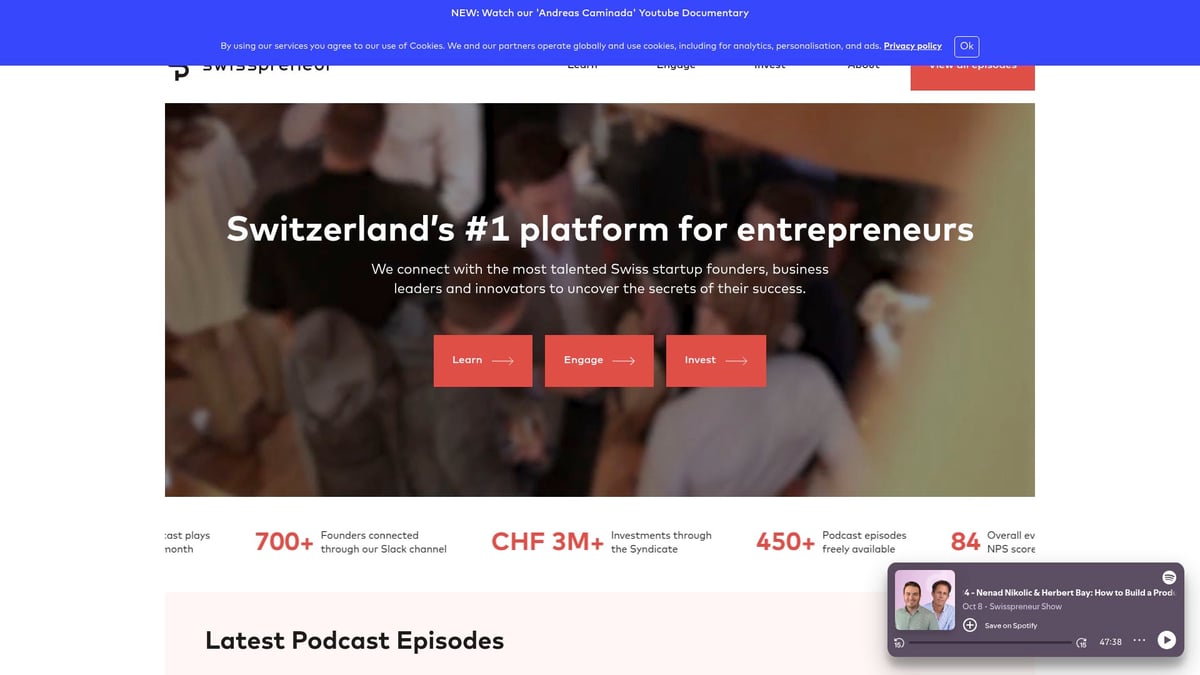Making a Business: The Definitive Guide for 2025
2025 is shaping up to be a pivotal year for entrepreneurs. New technologies, shifting regulations, and evolving markets are changing the rules of making a business. Founders are now navigating a landscape filled with both unprecedented opportunities and unique challenges.
This definitive guide is your roadmap to making a business that thrives in 2025. You’ll find actionable steps, expert insights, and up-to-date data at every stage of your journey. Are you ready to validate your idea, craft a winning plan, handle legal and financial setup, secure funding, build a top-tier team, launch to market, and scale for the future?
Dive in to discover the latest trends, inspiring success stories, and practical tools. Let’s turn your vision into a successful business—step by step.
Step 1: Validating Your Business Idea in 2025
Validating your business idea is the first critical step in making a business successful in 2025. The landscape is more competitive than ever, and entrepreneurs need to ensure their concept truly solves a real-world problem. This process requires a mix of data-driven research, rapid prototyping, strategic analysis, and a willingness to adapt quickly.

Understanding Modern Market Needs
In 2025, understanding market needs is the foundation of making a business that stands out. Modern founders rely on AI-powered tools like Google Trends and ChatGPT to uncover what customers actually want. Social listening platforms help identify pain points and emerging trends before they hit the mainstream.
Conducting customer interviews and surveys reveals hidden frustrations, guiding you toward a solution people will pay for. For example, some startups have used social listening to detect demand for eco-friendly packaging, pivoting their offerings early. Remember, according to Validating Startup Ideas Effectively, 42% of startups fail due to a lack of market need, highlighting why validation is essential.
Testing and Refining Your Concept
Once you spot a real problem, it is time to test your solution. Making a business in 2025 means building a Minimum Viable Product (MVP) quickly, often with no-code platforms that save time and resources. Launching a simple prototype lets you run lean experiments and gather real user feedback through beta launches or small pilot programs.
Collecting honest responses allows you to iterate your product before investing heavily. For instance, a SaaS startup might pivot its feature set after users reveal what they truly value. The goal is to let data, not assumptions, drive your next steps in making a business.
Evaluating Competition and Differentiation
A crucial part of making a business is knowing your competition. Modern tools make it easier to analyze competitors, from their pricing models to customer reviews. By conducting a SWOT analysis, founders can identify their unique value proposition and position themselves strategically.
Some niche brands have found success by differentiating on service or leveraging proprietary technology. Ask yourself: What sets your solution apart? Standing out is not just about being different, but about offering clear, compelling value that others do not.
Assessing Scalability and Future Potential
When making a business, think beyond the launch. Evaluate your tech stack for scalability and consider global market access from day one. The rise of remote-first and digital-native models means your idea could reach international customers faster than ever.
For example, some startups now expand into new countries within their first year, thanks to digital infrastructure and online platforms. Make sure your business model can grow without breaking, and always assess future potential during validation.
Common Pitfalls to Avoid
The journey of making a business comes with pitfalls. One of the biggest mistakes is relying solely on gut instinct instead of data. Ignoring negative feedback or failing to adapt to regulatory changes can also spell trouble.
Many new businesses run out of cash because they do not adjust their approach quickly enough. Stay flexible, listen to your customers, and make data-driven decisions at every step. Avoiding these pitfalls increases your chances of building a sustainable company in 2025.
Step 2: Crafting a Winning Business Plan
A strong business plan is the backbone of making a business succeed in 2025. With fierce competition and evolving investor expectations, founders need a clear blueprint that adapts to the realities of the modern market. This step covers the key components, financial planning, goal setting, risk management, and how to present your plan for maximum impact.

Essential Components of a 2025 Business Plan
When making a business plan for 2025, focus on clarity and relevance. Investors look for an executive summary that showcases vision and traction. Market analysis should use up-to-date data and trends. Outline your business model and monetization clearly, integrating sustainability and ESG (Environmental, Social, Governance) goals where possible.
A typical business plan structure includes:
- Executive summary
- Market analysis
- Business Models for Startups section
- Operations plan
- Financial projections
- Sustainability/ESG initiatives
For example, many startups now weave ESG goals into their core strategy, making a business not just profitable but also responsible.
Financial Forecasting and Budgeting
Financial planning is crucial when making a business plan. Use real-time data to build robust financial models, forecasting revenue, expenses, and cash flow. Scenario planning helps you prepare for economic shifts. Cloud-based accounting tools like Xero and QuickBooks let you update projections instantly.
Here is a quick comparison of financial tools:
| Tool | Purpose | Benefit |
|---|---|---|
| Xero | Accounting | Real-time syncing |
| QuickBooks | Budgeting/Forecasting | Automated reports |
| Planful | Scenario modeling | Multi-scenario analysis |
Remember, 82% of businesses that fail cite cash flow issues, so detailed budgeting is not optional for making a business thrive.
Setting SMART Goals and KPIs
Setting SMART goals is essential for making a business plan actionable. SMART stands for Specific, Measurable, Achievable, Relevant, and Time-bound. Choose KPIs that matter for digital-first ventures, such as user activation rate, monthly recurring revenue, and churn.
For example, a SaaS company might track:
- User activation rate (how many sign up and use the product)
- Customer churn (how many leave each month)
- Net Promoter Score (customer satisfaction)
Well-defined goals and the right KPIs keep making a business focused and accountable.
Risk Management and Contingency Planning
Every founder making a business plan in 2025 must address risks head-on. Start by identifying threats—market volatility, cybersecurity, supply chain issues. Build contingency plans that outline steps for each scenario.
Key areas to cover:
- Cybersecurity protocols
- Data privacy compliance
- Supply chain backup options
A recent case: An e-commerce startup faced supply chain delays but avoided losses by quickly switching to alternative suppliers, all thanks to solid risk planning.
Presenting Your Plan to Stakeholders
The way you present your plan can make or break the process of making a business. Tailor your pitch to investors, partners, and team members. Use interactive pitch decks and storytelling techniques to convey your vision.
Best practices include:
- Highlighting traction and milestones
- Using visuals and real-time data
- Practicing virtual pitches for remote audiences
A compelling presentation turns your business plan into a powerful tool for alignment and growth.
Step 3: Legal, Financial, and Regulatory Setup
Setting up the right legal, financial, and regulatory foundation is crucial when making a business in 2025. This step ensures your company is built on solid ground and ready for growth.

Choosing the Right Legal Structure
When making a business, your legal structure shapes everything from taxes to liability. In 2025, founders can choose from several options, including sole proprietorship, GmbH, and AG.
Here’s a quick comparison:
| Structure | Liability | Startup Costs | Best For |
|---|---|---|---|
| Sole Proprietorship | Personal | Low | Freelancers, solopreneurs |
| GmbH | Limited | Medium | Tech startups, SMEs |
| AG | Limited | High | Large, scalable ventures |
Understanding these differences is vital. For example, a Swiss tech startup might choose GmbH for flexibility, while a larger venture could prefer AG for easier fundraising. Always consult a local expert before making a business decision.
Registering Your Business and Intellectual Property
The next step in making a business is official registration and protecting your ideas. Start by selecting a unique business name and checking its availability.
Follow these steps:
- Register with the local commercial register
- Secure trademarks, patents, and copyrights
- Set up a digital signature for official documents
Trademark applications grew by 15% in Europe in 2023, showing how vital protection is. For a detailed, region-specific process, see this step-by-step guide to legally setting up a business. Safeguarding your intellectual property now prevents future headaches and builds credibility as you grow.
Navigating Taxation and Compliance
Making a business means understanding tax obligations right from the start. In 2025, digital tax filing and automation tools make compliance smoother.
Key steps:
- Research your tax rates and deadlines
- Use online platforms for digital filings
- Stay updated on GDPR, ESG, and sustainability standards
These regulations evolve quickly, so adapt your processes as needed. Many founders find that making a business future-proof means embedding compliance into daily operations, not just annual filings.
Setting Up Business Banking and Accounting
A modern business needs robust financial systems. When making a business, choose a fintech bank that offers seamless integration with cloud-based accounting tools.
Consider these essentials:
- Business bank account for transparency
- Payment gateway integration for easy sales
- Automated invoicing and expense tracking
For example, startups now use cloud platforms for real-time financial insights and quick decision-making. This approach keeps your making a business journey agile and audit-ready.
Insurance and Liability Considerations
Insurance is your safety net when making a business. Startups in 2025 typically need:
- General liability insurance
- Cybersecurity insurance
- Health and employee coverage
Evaluate risks specific to your sector. For instance, a tech company might prioritize cyber insurance, while a retailer may focus on property coverage. A real-world case: a startup avoided major losses from a data breach because they had the right policy. Making a business resilient means planning for the unexpected from day one.
Step 4: Funding and Financial Growth Strategies
Securing the right funding is a cornerstone of making a business thrive in 2025. With the landscape evolving rapidly, founders must understand the full spectrum of financial strategies to fuel sustainable growth. Whether you are bootstrapping or seeking outside investment, your approach to capital can shape every stage of your journey.
Bootstrapping vs. External Funding
When making a business in 2025, the choice between bootstrapping and seeking external funding is more nuanced than ever. Bootstrapping lets you keep control and stay agile, using personal savings or early revenues to launch. This route is popular, with about 60% of founders starting with their own funds.
On the other hand, external funding—like angel investors or venture capital—can accelerate growth but may mean giving up equity and decision-making power. Consider your business goals, industry standards, and risk tolerance when weighing these options. Both paths have produced standout success stories, proving there is no one-size-fits-all approach to making a business work.
Navigating Angel Investors, VCs, and Crowdfunding
For those making a business that needs more capital, understanding the funding landscape is crucial. Angel investors often bring not just money but mentorship and connections. Venture capitalists look for scalable, high-growth opportunities and can offer large sums, but expect rapid returns.
Crowdfunding has also matured in 2025. Platforms now offer both equity and reward-based models, opening doors for community-driven funding. To stand out, tailor your pitch to each audience, highlighting your unique value and growth potential. Remember, the right funding source should align with your vision for making a business that lasts.
Preparing for Due Diligence
No matter the funding source, preparing for due diligence is a must when making a business investment-ready. Investors will scrutinize your financials, legal documents, team structure, and market traction.
Be proactive by organizing your business plan, cap table, and compliance records. Address any red flags, like unclear ownership or inconsistent revenue figures, before they become dealbreakers. A transparent, data-driven approach builds trust and increases your chances of securing funding, helping your journey of making a business succeed.
Maximizing Grants and Government Support
Grants and government programs can be a game-changer for those making a business in 2025. From local startup incentives to EU innovation funds, founders have more opportunities than ever. For example, the EU allocated €13.5B for innovation support in 2024 alone.
Research eligibility requirements and customize your applications to each program. Focus on how your business delivers impact, innovation, or sustainability. Persistence pays off, as many grants are competitive. With the right approach, making a business that benefits from public support becomes much more achievable.
Financial Management for Sustainable Growth
Effective financial management is the backbone of making a business resilient. Cash flow is king, and many startups struggle here. In fact, 82% of businesses fail due to cash flow problems, making it vital to track expenses, forecast revenue, and minimize burn rate.
Leverage cloud-based dashboards to monitor your financial health in real time. Set clear budgets, review them often, and adapt as you grow. Sustainable financial practices set the stage for scaling, helping you build a business that can weather both opportunities and setbacks.
Swisspreneur: Empowering Swiss Startup Success
If you are making a business in Switzerland, Swisspreneur is an invaluable resource. As the nation’s leading platform for entrepreneurs, it offers podcasts, masterclasses, events, and an investment syndicate tailored for founders.

Swisspreneur connects you with experienced mentors, investors, and a vibrant community. Many Swiss startups have leveraged its resources to refine their strategies, build networks, and secure funding. For anyone making a business in 2025, tapping into Swisspreneur’s ecosystem can be a game-changer.
Step 5: Building Your Dream Team and Company Culture
Building the right team is at the heart of making a business succeed in 2025. With technology reshaping the workforce, founders must rethink how they attract, nurture, and empower talent. A strong team and company culture are more than buzzwords—they are your startup’s foundation and growth engine.
Hiring in the Digital Age
Hiring has transformed dramatically, and making a business in today’s landscape means tapping into global talent pools. Remote and hybrid work models allow you to recruit the best people, regardless of location. AI-driven recruitment platforms streamline the process, matching candidates to your needs quickly.
For example, startups have scaled internationally by building distributed teams from day one. This approach provides agility and resilience, ensuring you can adapt as your business grows. When making a business, prioritize flexible hiring strategies that leverage technology while maintaining a human touch.
- Use AI screening tools to reduce bias.
- Tap into specialized job boards for niche roles.
- Offer remote-first benefits to attract global talent.
Learn more about Building a Great Startup Team to set your company up for success.
Creating a Strong Company Culture
Company culture is the invisible glue that binds your team together. When making a business, define your mission, vision, and values from the outset. These guide every decision and attract people who share your purpose.
Diversity, equity, and inclusion are not just ethical imperatives—they drive results. According to McKinsey, diverse teams outperform by 35 percent. Make inclusion a priority with open communication, transparent policies, and regular feedback loops.
To build a lasting culture:
- Celebrate wins and learn from setbacks.
- Encourage cross-functional collaboration.
- Recognize and reward diverse perspectives.
A strong culture is essential for making a business that endures.
Onboarding, Training, and Retention
Onboarding sets the tone for every new hire. Effective programs help employees feel welcome, engaged, and productive from day one. In making a business, invest in digital onboarding tools and clear training paths.
Continuous learning is vital. Offer upskilling opportunities and encourage mentorship. One company reduced churn significantly by pairing new hires with experienced mentors, fostering a sense of belonging and growth.
Retention strategies to consider:
- Regular check-ins and feedback sessions.
- Access to online learning platforms.
- Clear career progression paths.
Focusing on development and support is key to making a business where people want to stay.
Leadership and Organizational Structure
The right leadership style can make or break your venture. Decide if a flat or hierarchical structure fits your vision. Many startups in 2025 opt for agile frameworks that empower teams to make decisions quickly.
Agile leadership values transparency and adaptability. Some companies have adopted holacracy, distributing authority to foster innovation and speed. Making a business today means prioritizing leadership that listens, learns, and leads by example.
Ask yourself:
- Is your structure flexible enough for rapid change?
- Do leaders model your company’s values?
- Are you empowering employees to take ownership?
With intentional leadership and the right structure, making a business becomes a journey of collective success.
Step 6: Go-to-Market and Scaling Strategies
Launching and scaling a company in 2025 demands more than just a great idea. To succeed at making a business, you need a strategy that adapts to the digital landscape, leverages new technologies, and connects with customers across borders.
Developing a Modern Marketing Strategy
In 2025, marketing is an omnichannel game. Making a business stand out means blending digital, social, content, and offline campaigns. Brands that succeed often create buzz through influencer partnerships and micro-communities.
Consider these core tactics:
- Mix social media with traditional outreach.
- Use content marketing to educate and engage.
- Run interactive campaigns on platforms like TikTok.
For example, a startup recently launched its product with a viral TikTok challenge, skyrocketing their customer base. The lesson? Making a business thrive today means being where your audience lives online.
Sales and Customer Acquisition in 2025
Sales funnels now rely on automation tools that streamline every step. Making a business grow requires building smart funnels that guide leads through awareness, interest, and conversion.
AI-driven CRMs help personalize outreach. This matters, as 80% of buyers expect tailored experiences (Salesforce, 2024).
Key strategies include:
- Automated lead scoring and follow-up.
- Personalized email sequences.
- Chatbots for instant customer support.
By focusing on data and automation, making a business more efficient is within reach for any founder.
Building Brand Authority and Trust
Trust is currency in 2025. Making a business memorable involves more than just products; it’s about storytelling, thought leadership, and visible social proof.
Ways to boost authority:
- Publish expert articles and case studies.
- Gather and showcase real customer testimonials.
- Engage in PR and founder-led storytelling.
A SaaS startup gained traction by sharing its founder’s journey, making a business feel relatable and authentic. Authority grows when your audience believes in your story.
Leveraging Technology for Growth
Technology is the backbone of rapid scaling. Making a business competitive means integrating AI, automation, and analytics from the start.
Popular tools include:
- SaaS platforms for marketing and sales.
- Automation software for repetitive tasks.
- Analytics dashboards for real-time insights.
Consider a startup that automated its onboarding and support, cutting costs and boosting revenue. In 2025, making a business tech-savvy is non-negotiable for growth.
International Expansion and Localization
Global markets are more accessible than ever. Making a business ready for international growth requires localization—adapting products, messaging, and support for each region.
Steps to expand:
- Research new markets and cultural norms.
- Translate and localize content.
- Offer region-specific support.
One startup tailored its product for the DACH region, quickly gaining market share. Making a business global means thinking local from day one.
Step 7: Measuring Success and Continuous Improvement
Measuring success is the heartbeat of making a business thrive in 2025. Continuous improvement means not just tracking what works, but also embracing change and innovation. Let’s break down the key ways founders can stay ahead, adapt, and take their business to the next level.
Tracking Key Metrics and Analytics
The foundation of making a business successful lies in knowing your numbers. Modern founders set up dashboards to track core KPIs in real time. Common metrics include customer acquisition cost (CAC), lifetime value (LTV), and conversion rates.
| KPI | What It Measures | Why It Matters |
|---|---|---|
| CAC | Cost to acquire a user | Budget efficiency |
| LTV | Customer value over time | Growth sustainability |
| Conversion Rate | % of users who buy | Funnel effectiveness |
With the right analytics, you can quickly spot trends, celebrate wins, and catch problems early. In making a business, using insights from data helps guide every decision.
Gathering and Acting on Customer Feedback
Listening to your customers is non-negotiable when making a business work. Tools like NPS and CSAT surveys capture satisfaction, while interviews reveal deeper insights. Teams also monitor reviews and social media for honest feedback.
- Implement NPS and CSAT surveys
- Conduct regular customer interviews
- Track reviews on platforms and social media
Companies using feedback loops grow twice as fast, according to Gartner. By taking action on what customers say, you can improve your product and build loyalty. Making a business better means turning feedback into real results.
Iterating and Pivoting for Long-Term Success
Agility is crucial in making a business that lasts. Embrace agile frameworks to test, learn, and refine your approach. Sometimes the data will show it’s time to pivot, whether that means shifting from B2C to B2B or changing your product focus.
- Review metrics regularly for patterns
- Hold sprint retrospectives for fast learning
- Don’t fear change if the data supports it
A real-world case: One startup shifted to serve business clients after user research, unlocking new revenue streams. Iteration keeps making a business resilient and ready for what’s next.
Staying Ahead of Trends and Innovation
In making a business, staying ahead means keeping your finger on the pulse of your industry. Monitor competitors, attend webinars, and invest in learning. Early adoption of new technology can give your company an edge.
- Set alerts for industry news
- Allocate budget for R&D
- Encourage team upskilling
For example, startups that invested early in AI tools led their markets. Making a business future-proof is about continuous learning and never standing still.
You’ve just explored the essential steps to launching a successful business in 2025—from validating your idea to building your team and scaling up. If you’re ready to turn these insights into real-world action and want to connect with other Swiss founders on the same journey, why not take the next step? Being part of a supportive community can make all the difference—you’ll get access to shared experiences, advice from fellow entrepreneurs, and opportunities to collaborate. Let’s build the future of Swiss entrepreneurship together.
Apply to our swiss founders community

